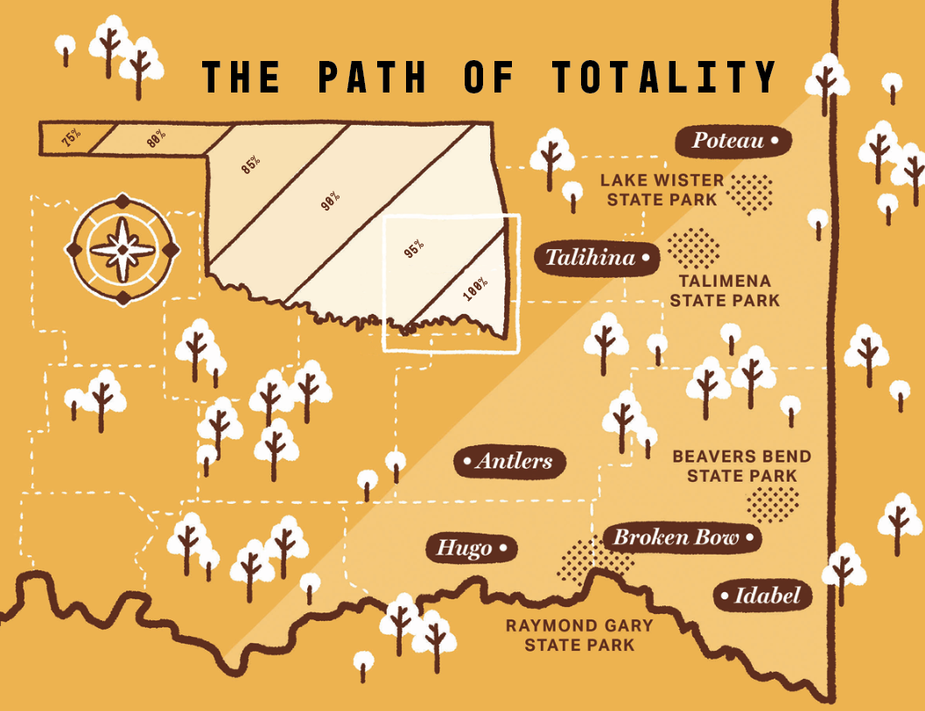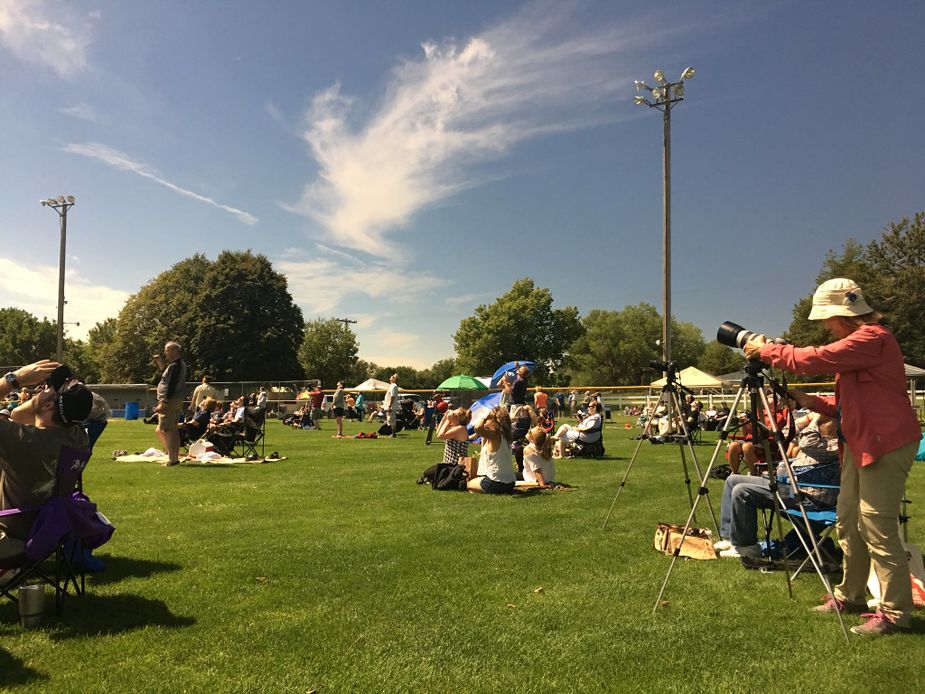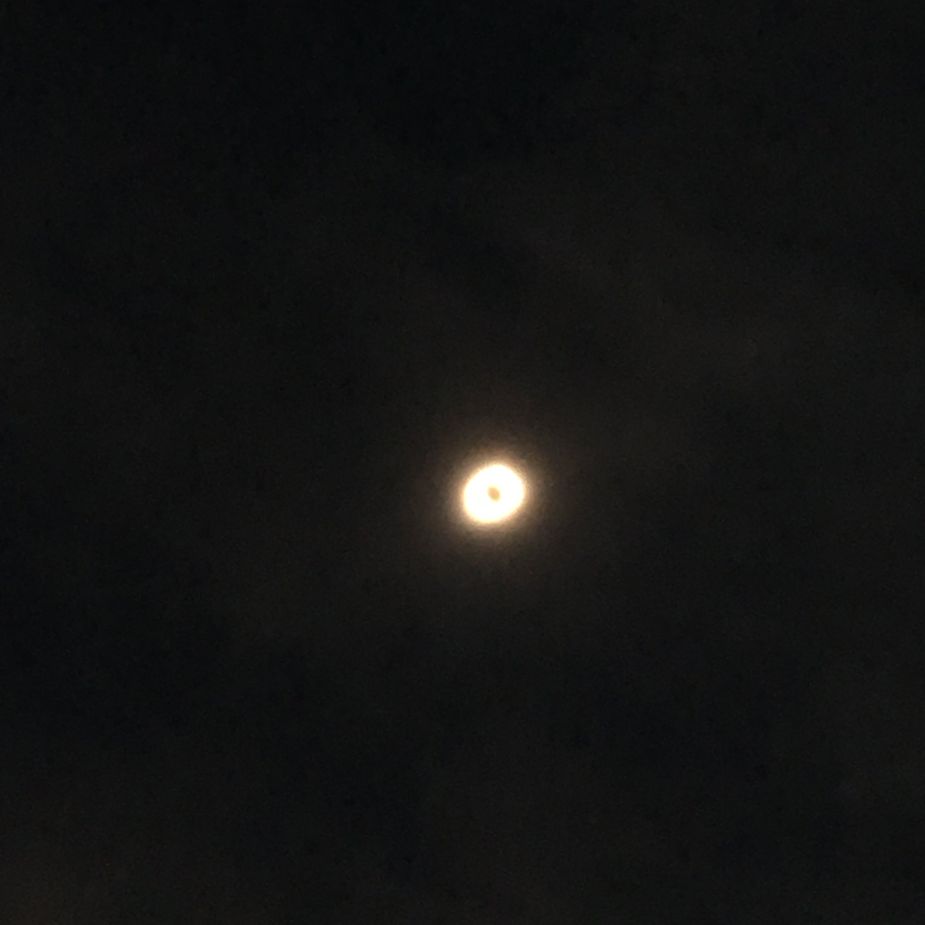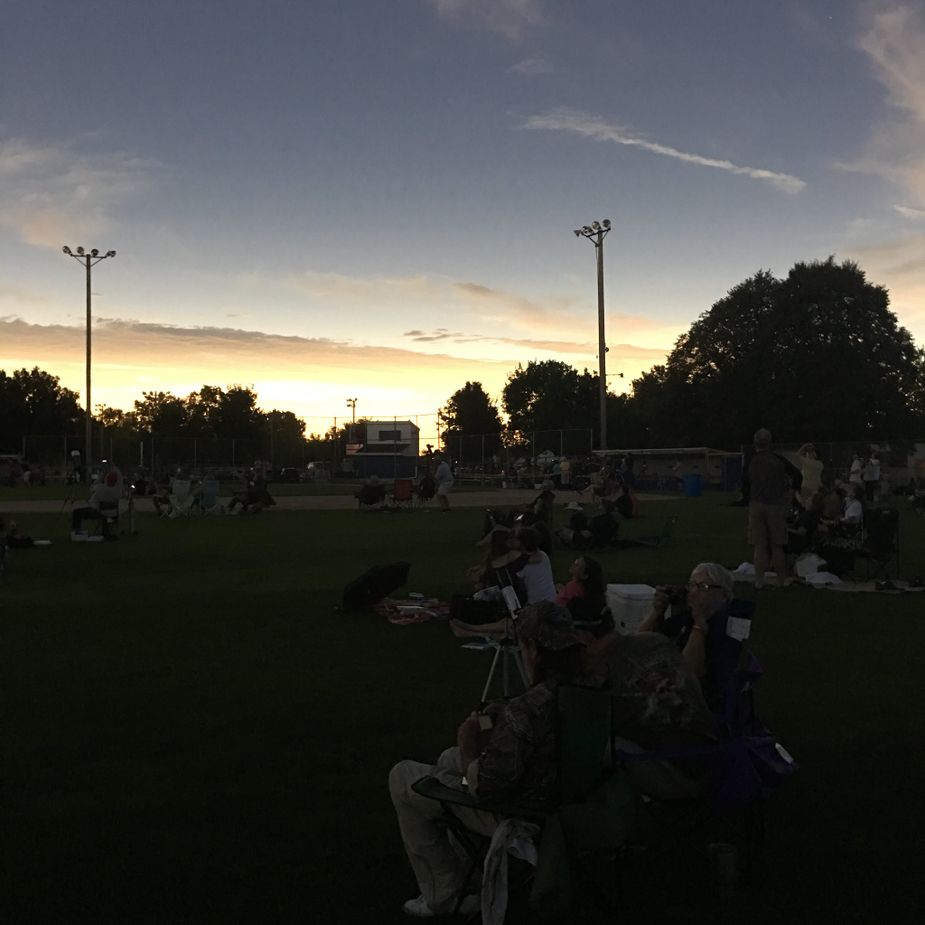Why You Should Make Sure to be in Southeastern Oklahoma for the April 8 Total Eclipse
Published February 2024
By Nathan Gunter | 7 min read
If you’re not aware by now, there’s a total solar eclipse on April 8, our soon-to-arrive March/April issue—featuring a Bigfoot cover illustrated by Dale Coons of Ponca City—will remedy you of that.
As you’ll read in this issue’s cover story, there are about two total solar eclipses somewhere on Earth every year—but since the planet is quite vast and mostly covered in water, it’s pretty rare that one happens close enough to get to see it. This year, while all the parts of Oklahoma will see some visible dimming of the sun—even the Panhandle will see 75 percent shadow—the path of true totality travels through the state’s southeastern quadrant.

ECLIPSE MAP ILLUSTRATION FROM ISSUE. Illustration by JJ Ritchey
In my life, I’ve experienced two solar eclipses. The first was when I was in the eighth grade—an annular eclipse threw the moon’s shadow across a swath of North America, including a wide swath of western Oklahoma. Where I was stationed on that day—at Brink Junior High in Moore—we were told we’d only be seeing a 98 percent eclipse as opposed to full totality.
I remember two main things about that day. One was disappointment: Even at the moment of highest coverage, it felt like just another cloudy day. It was a hazy spring Oklahoma sky, which didn’t help, but the moment of greatest darkness felt the same as a cloud passing over the sun. This experience, which I’d been so excited for, was a bit of a dud.
The second thing I remember is that this kid Erik came up and took my eclipse viewer off as I was looking at the sun, because fourteen-year-old boys are all sociopaths, every last one of them. Myself included.
Fast forward twenty-three years. No longer adolescent, I gleefully discovered that there would be a total solar eclipse. And not wanting to be disappointed this time, I loaded up my sweetie, and we took off for Ravenna, Nebraska—a small town I’d chosen more or less at random that would be in the path of totality, about eight hours north of Oklahoma City. We drove up, camped at a state park, and got up early to get good seats at Ravenna’s watch party.

Ravenna, Nebraska, during the total solar eclipse of 2017. Photo by Nathan Gunter
As the moon began to cover the sun that day from the perspective of Ravenna, my entire previous eclipse experience was, well, eclipsed. It was the spookiest, weirdest, and most eerie experience of my life—and also one of the most meaningful. As the moon’s shadow swept across Nebraska, the light changed, as if the sun had been replaced in the sky by a different star from somewhere else in the galaxy.

Eclipsing sun
I understood, there in the lunar dusk, why ancient peoples found these experiences so ominous—even to my science-informed perspective, the part of me that knew what was going on, the occasion assumed an air of cosmic significance. I took turns alternately staring at the eclipse through my viewer and looking around me to see my world bathed in a kind of light I’d never seen before. I took in the crescent-shaped shadows on the ground and listened to the awed expressions of the other people there.

Full totality
In a few minutes it was over, and as the sunlight returned, people broke out into spontaneous applause—way to go, Moon and Sun, it seemed to say. We all knew we’d experienced something special that day. I barely noticed the slow traffic as we left town.
Two eclipse experiences, totally different. I tell you these two stories to emphasize how much different—how much higher a quality the experience—is for those who make it a point to enter the zone of totality. So even if it’s just to drive down and back for the day—you’ll want to be stationed at your viewing spot no later than about 1:30 at the latest, as totality begins around then.
Places to overnight may be difficult to book at this late stage, so if you do find something open, book away. Otherwise, you may be down for a day trip to southeastern Oklahoma (I recommend making an early dinner reservation at Reba’s Place in Atoka for the drive back).
Having done this for myself, I can pretty much promise you’ll find the trip worthwhile. The chance to be present for this kind of celestial happening inspires thousands to go globetrotting every year in search of that magical light. This April, it’s coming to us—and to a part of the state that’s rich in gorgeous scenery, plenty to see, and great food to boot.
Pick up our March/April issue to find out how you can get your own set of commemorative eclipse glasses. Current subscribers and those who subscribe online by March 22 will receive them in the mail. We hope to see you in the southeast on April 8.
"Oklahoma Today Podcast: February 19"
"Weekly Events Calendar: February 26-March 3"
You May Like
Weekly Events Calendar: July 14-20, 2025
This week in Oklahoma: Fifty years of Eskimo Joe's in Stillwater; a Food Network star in Durant; and life's a peach in Porter and Stratfo...
This week in Oklahoma: Fifty years of Eskimo Joe's in Stillwater; a Food Network star in Durant; and life's a peach in Porter and Stratford.
Oklahoma Today Podcast: July 14, 2025
On this week's podcast we learn all about the Aquilops, a tiny little dinosaur discovered by researchers at Sam Noble Museum in Norman.
On this week's podcast we learn all about the Aquilops, a tiny little dinosaur discovered by researchers at Sam Noble Museum in Norman.
A Pink Paradise
Any book store is a good time, but this one's got a specialty soda bar.
Any book store is a good time, but this one's got a specialty soda bar.










